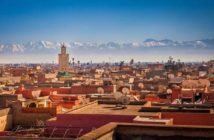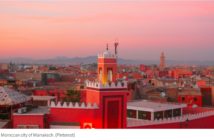m.theaustralian.com.au | Stanley Stewart
Camel caravan in the Sahara. Picture:Thinkstock Source:Supplied
IN Marrakech, the restless and the romantic talk of the Sahara as some kind of solution. For all its pleasures, the narrow lanes of the fabled pink city tend to claustrophobia.
The desert offers escape from the crowds, the noise and the sense of urban corruption. Long-time residents dream of the Sahara the way New Yorkers dream of Montana.
I hire a car and head south to see what it’s all about. Traffic is light — a few donkey carts, a couple of wheezing trucks, a shepherd running after his flock. In the Atlas foothills, women are washing clothes in streams beneath red stone villages.
Along the roadside men hold up things to buy — ceramics, rock crystals; it’s the last gasp of Marrakech commercialism before I cross the watershed.
From the top of Tizi-n-Tichka pass I spin down the southern flanks of the Atlas following the switchback road through spectacular canyons.
Far below, the desert is opening, stretching to unfathomable distances. A thousand miles away, straight as the camel gallops, lies Timbuktu.
On the outskirts of Ouarzazate, at the beginning of the Dades Valley, I stop to give a lift to an elderly gentleman. A young boy is holding his hand.
It is only as the two climb into the car that I realise the old man is blind. He sits forward in the front seat beside me, his head turned. He doesn’t want to miss a sound.
We chat about the weather, about the road over the mountains from Marrakech. The boy, patient with my schoolboy French, is acting as interpreter. “But why did you want to come to the Dades?” the old man asks at last.
“Gouter le desert,” I reply, coming over all Paul Bowles. To taste the desert, hoping the phrase conveys the idea of experience and not just lunch.
“Stones,” the old man laughs. “That is what my father used to say.
“The desert air tastes of stones. A clean nothingness.”
Beyond the window, spectacular expanses of nothingness run away toward the mountains.
The old man invites me to his house. I demur. It is late; his village is out of the way. But there is something else — Marrakech has made me cynical. In Marrakech, invitations almost always have an agenda, whether a sale, a hotel booking, a visit to an uncle’s shop.
However, when I reach the old man’s turning there is a car already waiting for him; he is not looking for a ride to his door. There has been no agenda, only a gesture of hospitality.
The old man leans in at the window. “You are busy. Come to see me when you have time.
“Ouled Merzoud,” he adds, naming his village. “Ask for Ibrahim, the blind musician.”
An evening wind has picked up, flapping his robes. And then a great cloud of dust envelops him and he vanishes in the rear view mirror, like a mirage.
The Dades Valley runs for about 160km between the Atlas Mountains and the Djebel Sahro range in the northern hinterlands of the Sahara. Its landscapes are harsh and elemental. It is a backdrop that has drawn film directors here since the late 1950s. Lawrence of Arabia was shot here, as were The Sheltering Sky (based on Paul Bowles’s book), Gladiator, The Jewel of the Nile and scores of other films whose directors wanted their landscapes to be big characters.
For centuries the Dades was one of the chief destinations of the great trans-Saharan caravans as well as the stepping stone for onward routes across the Atlas to Marrakech and the rest of Morocco.
Dades came to be known as the Valley of a Thousand Kasbahs, founded on the profits of this desert trade. Morocco’s equivalent of the feudal castle, the kasbahs were built in the desert’s Manichean secret — the oases, those sudden islands of greenery that are everything the desert is not. Desert travellers tend to come over all emotional when it comes to oases. Many liken them to the arrival in paradise, others to a feminine embrace after the harsh battering of the desert.
The wonder is that you enter an oasis as you would a house, stepping across the threshold, crossing in a single stride from the desert to the sown, from barren wastelands to green shadows and bubbling water, to blossom scent and birdsong.
In the dry wastes of the Sahara, this sweetness verges on the miraculous.
I am heading to Skoura, one of the great palmeraie of the Sahara and the largest and most beautiful of the Dades oases, fed by seasonal rivers and underground springs.
Its groves of date and coconut palms, laid out in the 12th century by the Almohad sultan Yacoub
al-Mansour, have been passed down through generations like family heirlooms.
Caravans set off from the kasbahs of Skoura laden with dates and almonds, figs and olives, grapes and pomegranates, bound for Marrakech, a week’s journey over the mountains.
Skoura is a green labyrinth. Follow the dust lanes that meander through the palmeraie and in a moment you are lost among the orchards and the blank adobe walls hiding unseen houses.
Donkeys and bicycles flicker through the shadows, children chase deflated footballs, women carry bundles of cut alfalfa home for their animals, and august gentlemen come out to stroll in the late afternoon, greeting passers-by with a slight bow and elaborate salutations.
At night, beneath a vast sky of stars, a heavy silence falls, broken only by frogs croaking and the occasional voice drifting through the palm groves.
There are up to 100 kasbahs in Skoura, sailing like galleons above the waves of greenery.
They are huge, rambling, fantastical, a child’s dream of a castle with a full complement of turrets and towers and colossal gateways.
Many are in ruins, the ultimate haunted houses.
Inside, you climb narrow stairways, flit along dark passageways, fumble at the latches of heavy doors, duck beneath low arches and emerge eventually on flat roofs with views over the heads of the surrounding palm trees.
In the gardens of Ait Abou, one of Skoura’s largest and best-preserved kasbahs, the walls rise above us like a giant sandcastle. Milk water bubbles through the irrigation channels.
“Kasbahs may be fortifications,” jokes Muhammed, the owner, “but I think they were chiefly a defence against the enemy within — the wives.
“This was my grandfather’s kasbah. I was brought up here. But even I am not really sure how many wives there were.” Moroccan sheiks tended to overdo it on the wife front.
If the kasbahs sprawled, locals say it was because the harem did. If they contained labyrinthine passages and a plethora of rooms, it was because complex family arrangements required a great deal of space and discretion.
The following day I go to find Ibrahim. In the village of Ouled Merzoud I pick my way through the lanes, crossing and re-crossing tiny footbridges over the irrigation channels.
Ibrahim lives with his wife, several children and a small tribe of grandchildren. I am ushered upstairs like visiting royalty into the room where Ibrahim sits on a low divan by an open window, enjoying the sounds and the smell of the oasis.
“My friend,” he says, taking my hand and drawing me to a place beside him, “how is the desert’s taste?” His voice has a teasing note. “My wife is going to bring almond cakes … we don’t want to leave you just with the taste of stones. How is your Sahara?”
“Too big to comprehend,” I tell him.
“It is. The desert goes on and on. That’s why we have oases. Something finite. They say if you go far enough in the desert, you will reach paradise. But no one comes back from that journey to tell us the way. Myself, I think paradise could be somewhere closer, in the oasis.”
His wife brings glasses of sweet mint tea and the promised almond cakes. Grandchildren walk in and out to get a glimpse of the foreigner. Each of them comes forward and kisses the old man’s hand as a mark of respect when they enter the room.
After some prompting from his wife, Ibrahim consents to sing for me. He turns his face towards the light from the window and sings in a voice like the landscape — harsh, elemental and beautiful. When he has finished I ask about the words. The grandson translates. “My heart is a desert. It wants to flower like an oasis. Do not leave me with the taste of stones.”
Stanley Stewart was a guest of Audley Travel.
Checklist
The drive over the Atlas from Marrakech to Skoura takes about four hours on a good road. Audley Travel can arrange a car and a driver. More: audleytravel.com.
Sawadi is a small organic farm in Skoura run by a French couple, with seven traditional cottages dotted among the gardens; there’s a pool and restaurant. More: sawadi.ma.
Also at Skoura, Dar Ahlam is a stunning kasbah and one of the finest properties in Morocco. More: relaischateaux.com;mrandmrssmith.com/dar-ahlam.
Email a friendShare on TwitterShare on FacebookShare on LinkedIn
.







